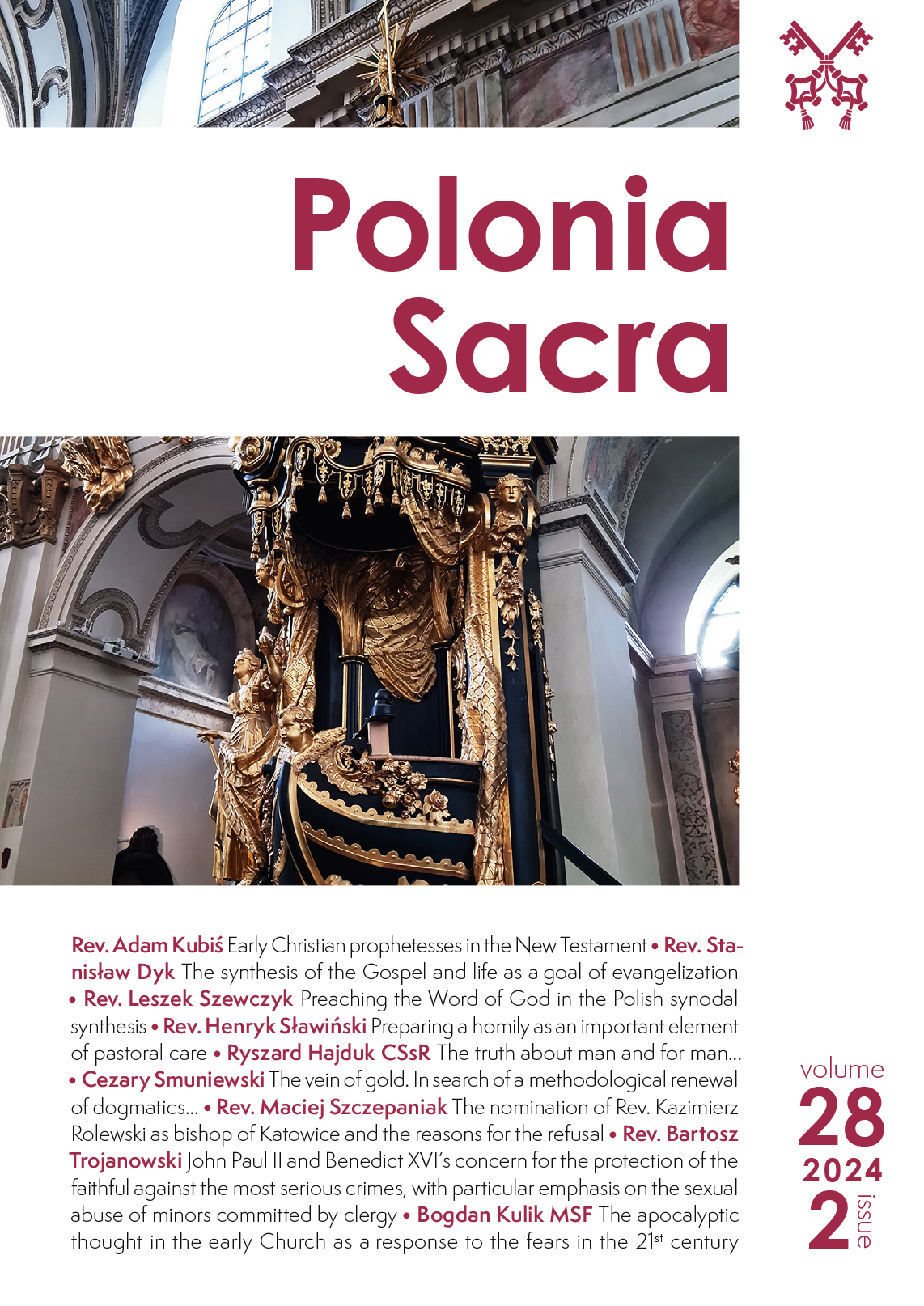Preparing a homily as an important element of pastoral care
DOI:
https://doi.org/10.15633/ps.28204Keywords:
preparation, homily, Benedict XVI, FrancisAbstract
The homily, which the Second Vatican Council assigned a special role among various forms of preaching the Word of God, is an important task for those, who are entrusted with pastoral care. The faithful eagerly listen to homilies, but at the same time, they often complain that their level is too low and expect homilies on the good level. Yet, the solution to the problem lies in good preparation of the homily. Also, preachers must be convinced that the time allocated for this is one of their most important pastoral duties. We have evidence of how the last popes, Benedict XVI and Francis, prepared their homilies. Working on a sermon is a creative process that goes through the following phases: research and collection of materials, incubation, illumination, and verification. The fruit of reflection and prayer is a homily characterized by Christocentrism, a positive message from which a moral call arises; it contains the teaching of the Church, actualizes the word of God, introduces the celebrated liturgy, and is single-thematic. Hence, in the pastors’ belief in the important role of the sermon and its reliable preparation, there is an opportunity to improve the quality of the homily.
References
Benedict XVI, Sacramentum caritatis, Mar 13, 2007.
Benedict XVI, Verbum Domini, Sep 30, 2010.
Bergoglio J. M., Nei tuoi occhi é la mia parola. Omelie e discorsi di Buenos Aires 1999–2013, Milano 2016.
The Bishop’s Committee on Priestly Life and Ministry, Fulfilled in Your Hearing. The Homily in the Sunday Assembly, Washington 1982.
The Council of Trent, Session 5, II: On preachers of the word of God, and on Questors of alms, 11, http://www.thecounciloftrent.com/ch5.htm (Oct 9, 2023).
Dąbrówka M., „Zaprowadzi ich do tryskających zdrojów”. Treści mistagogiczne przepowiadania homilijnego, in: Homilia integralna. Studium treści przepowiadania homilijnego, eds. M. Dąbrówka, M. Klementowicz, Tarnów 2017, pp. 149–170.
Derdziuk A., Treści teologicznomoralne w homilii, in: Homilia integralna. Studium treści przepowiadania homilijnego, eds. M. Dąbrówka, M. Klementowicz, Tarnów 2017, pp. 107–116.
Draguła A., Chrystocentryczna interpretacja ludzkiej kultury, in: Głosimy Pana Jezusa Chrystusa. Treść przepowiadania, ed. by H. Sławiński, Kraków 2017, pp. 295–308.
Duffy K., Pope Francis and the Search for Solutions to the Bad Sermon Phenomenon, Mar 27, 2023, https://churchlifejournal.nd.edu/articles/pope-francis-and-the-search-for-solutions-to-the-bad-sermon-phenomenon/ (Nov 20, 2023).
Dyk S., Homilia w osmozie z teologią liturgiczną, „Polonia Sacra” 21 (2017) no. 2, pp. 27–43.
Dyk S., Sławiński H., Szewczyk L., Przepowiadanie homilijne w Polsce. Analiza aspektów treściowych i formalnych wybranych homilii, „Collectanea Theologica” 93 (2023) no. 2, pp. 189–225.
Fares D. J., Dziesięć rad papieża Franciszka dla kapłanów, Łódź 2018.
Francis, General Audience, Feb 7, 2018, https://www.vatican.va/content/francesco/en/audiences/2018/documents/papa-francesco_20180207_udienza-generale.html (Nov 10, 2023).
Francis, Papal Speeches. In-Flight Press Conference, Aug 6, 2023, https://www.vatican.va/content/francesco/en/speeches/2023/august/documents/20230806-portogallo-voloritorno.html (Sep 10, 2023).
Francis, Christus vivit, Mar 25, 2019.
Francis, Evangelii gaudium, Nov 24, 2013.
Francis, Desiderio desideravi, Jun 29, 2022.
General Secretariat of the Synod, Synod 2021–2024. For a Synodal Church: Communion, Participation, Mission. “Enlarge the Space of Your Tent” (Is 54:2). Working Document for the Continental Stage, Vatican City, October 2022, https://www.synod.va/content/dam/synod/common/phases/continental-stage/dcs/Documento-Tappa-Continentale-EN.pdf (Sep 7, 2023).
Lamb Ch., Catholic homilies are often a ‘disaster’ says Pope, “The Tablet”, Jan 24, 2023, https://www.thetablet.co.uk/news/16448/catholic-homilies-are-often-a-disaster-says-pope (Aug 2, 2023).
Olejnik S., W odpowiedzi na dar i powołanie Boże. Zarys teologii moralnej, Warszawa 1979.
Orzoł M., Odpowiedź na wezwanie. Treści parenetyczne przepowiadania homilijnego, in: Homilia integralna. Studium treści przepowiadania homilijnego, eds. M. Dąbrówka, M. Klementowicz, Tarnów 2017, pp. 117–130.
Pontifical Council for Justice and Peace, Compendium of the Social Doctrine of the Church, https://www.vatican.va/roman_curia/pontifical_councils/justpeace/documents/rc_pc_justpeace_doc_20060526_compendio,dott-soc_en.html (Aug 6, 2022).
Second Vatican Council, Christus Dominus, Oct 28, 1965.
Second Vatican Council, Presbyterorum ord, Dec 7, 1965.
Sławiński H., Chrystus urzeczywistnił Pismo, Kraków 2007.
Sławiński H., Inspiracje Franciszka dla posługi słowa, „Polonia Sacra” 25 (2021) no. 4, pp. 43–62.
Sławiński H., Kultura lokalna jako kontekst przepowiadania globalnego orędzia, „Roczniki Teologiczne” 66 (2019) no. 12, pp. 95–106.
Sławiński H., Konieczność przygotowania homilii. Na kanwie aktualnych polemik o pomocach kaznodziejskich, „Przegląd Homiletyczny” 12 (2008), pp. 17–24.
Smith Ch., The Sociology of a Superb Sermon, Apr 30, 2019, https://churchlifejournal.nd.edu/articles/the-sociology-of-a-superb-sermon/ (Nov 20, 2023).
Synod 2021–2023. Synteza krajowa. Ku Kościołowi synodalnemu: komunia, uczestnictwo, misja, koordynacja A. J. Galbas, Ruda Śląska 2022, https://synod.org.pl/wp-content/uploads/2022/08/Synteza_SYNOD_2021_2023_mobile.pdf (Aug 6, 2023).
Szewczyk L., Chrystocentryczne głoszenie zasad życia chrześcijańskiego, in: Głosimy Pana Jezusa Chrystusa. Treść przepowiadania, ed. by H. Sławiński, Kraków 2017, pp. 173–196.
Twardy J., Koncepcja pracy twórczej nad kazaniem. Inspiracje psychologiczne w niemieckojęzycznych publikacjach homiletycznych 1970–1996, Rzeszów 1998.
Wiśniewski J., Homilia w teorii i praktyce Benedykta XVI, Kraków 2021.
Downloads
Published
Issue
Section
License
Copyright (c) 2024 Henryk Sławiński

This work is licensed under a Creative Commons Attribution 4.0 International License.
Authors who publish in this journal agree to the following terms:
- Authors retain the copyright and full publishing rights without restrictions and grant the journal right of first publication with the work simultaneously licensed under a Creative Commons Attribution 4.0 International License that allows others to share the work with an acknowledgement of the work's authorship and initial publication in this journal.
- Authors are able to enter into separate, additional contractual arrangements for the non-exclusive distribution of the journal's published version of the work (e.g., post it to an institutional repository or publish it in a book), with an acknowledgement of its initial publication in this journal.
- Authors are permitted and encouraged to post their work online (e.g., in institutional repositories or on their website) prior to and during the submission process, as this can lead to productive exchanges, as well as earlier and greater citation of published work (See The Effect of Open Access).

